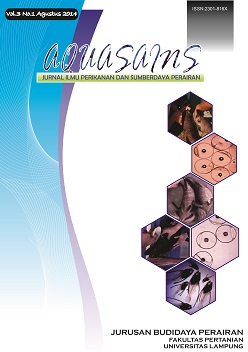Konsentrasi Efektif (EC50-1Jam) Ekstrak Akar Tuba (Derris elliptica) Sebagai Bahan Anestesi Benih Ikan Mas (Cyprinus carpio)
Abstract
Tuba (Derris elliptica) root was used traditionally as a poison to fish catching. This research looks for beneficial of tuba root extract as an anesthetic for the transport of fish seed. This research aims was to explore the value of effective concentration (EC50 - 1 hr) of tuba root extracts by ethanol and hexane, as well as determine the effect of the effective concentration value and the period of transportation time on the survival and growth of common carp seed. Probit analysis used to determine the effective concentration , whereas to determine the effect of differences of periods of transportation (2 , 4 and 6 hours) and the value of the effective concentration of each solvent on the survival and growth of the research design uses factorial analisis. The results of probit analysis for ethanol and hexane solvent are 6.166 and 3.72 ppm. Transportation showed the highest survival rate at treatment of transportation period 2 hour with values reaching an average of 100%, while the highest growth occurres in hexane treatment on the period of transportation of 6 hours. This results also found that the period of transportation differences significantly affect the survival of common carp seeds but has no significant effect on the growth of common carp other results showed that the difference in the solvent not significantly affect the survival and growth of common carp seed.
Downloads
Downloads
Published
How to Cite
Issue
Section
License
License for Authors
Authors who publish with this journal agree to the following terms:
- Authors retain copyright and grant the journal right of first publication with the work simultaneously licensed under a Creative Commons Attribution License that allows others to share the work with an acknowledgement of the work's authorship and initial publication in this journal.
- Authors are able to enter into separate, additional contractual arrangements for the non-exclusive distribution of the journal's published version of the work (e.g., post it to an institutional repository or publish it in a book), with an acknowledgement of its initial publication in this journal.
- When the article is accepted for publication, its copyright is transferred to Aquasains Journal. The copyright transfer convers the exclusive right to reproduce and distribute the article, including offprint, translation, photographic reproduction, microfilm, electronic material, (offline or online) or any other reproduction of similar nature.
- Authors are permitted and encouraged to post their work online (e.g., in institutional repositories or on their website) prior to and during the submission process, as it can lead to productive exchanges, as well as earlier and greater citation of published work (See The Effect of Open Access).
- The Author warrant that this article is original and that the author has full power to publish. The author sign for and accepts responsibility for releasing this material on behalf os any and all-author. If the article based on or part os student’s thesis, the student needs to sign as his/her agreement that his/her works is going published.
License for Regular Users
Other regular users who want to cite, distribute, remix, tweak, and build upon author’s works, even for commercial purposes, should acknowledge the work’s authorship and initial publication in this journal, licensed under a Creative Commons Attribution License.
This license lets others distribute, remix, tweak, and build upon your work, even commercially, as long as they credit you for the original creation.
This work is licensed under a Creative Commons Attribution 4.0 International License.Copyright Transfer Statement can be downloaded here


.png)









